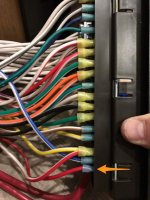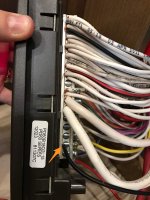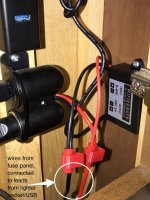David-and-Cheryl
Well-known member
This is kind of a long set-up, but I wanted to provide as much information as possible to help troubleshoot this mystery.
Some months ago, I pulled a brand new circuit from our Progressive Dynamics PD60 12v power distribution center to our nearby tech cabinet, which houses our WiFiRanger router and Netgear hotspot. I connected the circuit to one of the unused fuse connections (#17) at the bottom of the fuse panel, which already had a 15A fuse in it. The cabinet end of the circuit terminates in a combination 12v lighter socket/2 USB adapter. The WiFiRanger was plugged into that using its lighter socket power adapter, and everything has worked well.
Recently, however, we started noticing that the external antenna that the router powers was rebooting itself frequently. While troubleshooting that problem, WiFiRanger support suggested that our 12v power might be the cause, and noted that the router works best on 24v when it has to supply power to connected devices like the external antenna and hotspot. They recommended that we get the 24v step-up converter that is now included with their newer systems.
So, I ordered that converter, spliced it in to the tech cabinet circuit just before the lighter socket/USB adapter, and plugged in the router. After that, things went haywire. Our ceiling lights in the bathroom and bedroom all went out. I checked the fuse panel and fuse #5 was blown. Note that this is a completely different circuit from the one powering the tech cabinet. I unplugged the router, replaced fuse #5 and power was restored to the lights.
However, when I connected the 24v converter to the router, the fuse blew again and the lights went out. The router, however, had normal power.
It gets weirder. When I pulled the power plug out of the router, I noticed that the lights flickered. So I pulled fuse #5 (the one for the lights), but before I replaced it, I plugged the router back in. Just as the plug made contact with the router, the lights came on, even though there was no fuse for the lights in the fuse panel. Then when I pushed the power plug all the way into the router, the router came on, and the lights went out (although a couple of them are actually on but very dim--they are LEDs). Finally, with the router connected to power, I can't get the lights to come on, even with a working 15A fuse in the panel. I also tried a 20A fuse with the same result. The 12v power adapter for the router does the same thing, even though it used to work fine. No other 12v circuits in the trailer are affected as far as I can tell.
It looks like what's happening is that when the DC power plug from either the 24v converter or the 12v lighter socket adapter is shorted, a circuit is somehow completed to the lights, even though that should be impossible with the fuse out of the panel. But when the power plug is actually powering the router, it overloads the light circuit, blowing fuse #5, and the lights go out because there isn't enough current "leaking" from circuit #17 to also power the lights. Somehow the mere presence of the 24v converter is causing all of this, even when it's not powering the router.
Can someone PLEASE tell me how to go about diagnosing and resolving this problem? Those should be two completely different circuits, but obviously they're not.
Some months ago, I pulled a brand new circuit from our Progressive Dynamics PD60 12v power distribution center to our nearby tech cabinet, which houses our WiFiRanger router and Netgear hotspot. I connected the circuit to one of the unused fuse connections (#17) at the bottom of the fuse panel, which already had a 15A fuse in it. The cabinet end of the circuit terminates in a combination 12v lighter socket/2 USB adapter. The WiFiRanger was plugged into that using its lighter socket power adapter, and everything has worked well.
Recently, however, we started noticing that the external antenna that the router powers was rebooting itself frequently. While troubleshooting that problem, WiFiRanger support suggested that our 12v power might be the cause, and noted that the router works best on 24v when it has to supply power to connected devices like the external antenna and hotspot. They recommended that we get the 24v step-up converter that is now included with their newer systems.
So, I ordered that converter, spliced it in to the tech cabinet circuit just before the lighter socket/USB adapter, and plugged in the router. After that, things went haywire. Our ceiling lights in the bathroom and bedroom all went out. I checked the fuse panel and fuse #5 was blown. Note that this is a completely different circuit from the one powering the tech cabinet. I unplugged the router, replaced fuse #5 and power was restored to the lights.
However, when I connected the 24v converter to the router, the fuse blew again and the lights went out. The router, however, had normal power.
It gets weirder. When I pulled the power plug out of the router, I noticed that the lights flickered. So I pulled fuse #5 (the one for the lights), but before I replaced it, I plugged the router back in. Just as the plug made contact with the router, the lights came on, even though there was no fuse for the lights in the fuse panel. Then when I pushed the power plug all the way into the router, the router came on, and the lights went out (although a couple of them are actually on but very dim--they are LEDs). Finally, with the router connected to power, I can't get the lights to come on, even with a working 15A fuse in the panel. I also tried a 20A fuse with the same result. The 12v power adapter for the router does the same thing, even though it used to work fine. No other 12v circuits in the trailer are affected as far as I can tell.
It looks like what's happening is that when the DC power plug from either the 24v converter or the 12v lighter socket adapter is shorted, a circuit is somehow completed to the lights, even though that should be impossible with the fuse out of the panel. But when the power plug is actually powering the router, it overloads the light circuit, blowing fuse #5, and the lights go out because there isn't enough current "leaking" from circuit #17 to also power the lights. Somehow the mere presence of the 24v converter is causing all of this, even when it's not powering the router.
Can someone PLEASE tell me how to go about diagnosing and resolving this problem? Those should be two completely different circuits, but obviously they're not.




